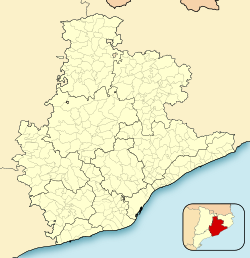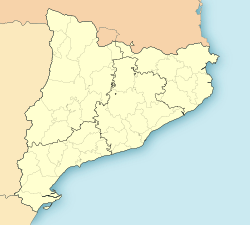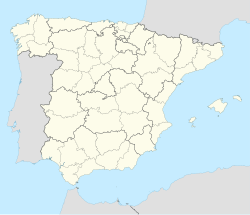Molins de Rei (Catalan pronunciation: [muˈlinz ðə ˈrej]) or Molins de Rey in Spanish is a municipality located 18 km from Barcelona's city centre, in the comarca of Baix Llobregat in Catalonia, Spain. It is situated on the left bank of the Llobregat river, on the A-7 autopista from Valencia to La Jonquera and the main N-II road.
Molins de Rei
Molins de Rey | |
|---|---|
Castellciuró Castle. | |
| Coordinates: 41°24′50″N 2°00′57″E / 41.41389°N 2.01583°E | |
| Country | |
| Community | |
| Province | Barcelona |
| Comarca | Baix Llobregat |
| Government | |
| • Mayor (2019— ) | Martulina Espallargas |
| Area | |
• Total | 15.9 km2 (6.1 sq mi) |
| Elevation | 37 m (121 ft) |
| Population (2018)[2] | |
• Total | 25,687 |
| • Density | 1,600/km2 (4,200/sq mi) |
| Demonym | Molinenc |
| Website | www |
Its location has made Molins de Rei a strategic and dynamic municipality, with significant examples of commercial and industrial entrepreneurship.
History
editIts name, Molins de Rei (which means King's Mills), has its origins in the royal windmills that existed in this area, documented as early as 1188. These mills were built by order of the King Alfonso II, and their construction essentially established the municipality. By 1208, a parish and church as well as a cemetery had been built in the town.
In 1309, the town was part of the county of Pallars which belonged to the countess Sibil·la. When she died, the town changed owners to Hugo de Arborea and later on, it was transferred to the convent of Santa Clara in Sardinia (Italy). Again in 1366, the lands were purchased by Berenguer de Relat. In 1430, it was again transferred to Galceran de Requesens i de Santacoloma who built a palace in the village, visited by personalities of the time such as the Catholic Monarchs or Christopher Columbus.[1]
In 1763, a bridge was built to cross the Llobregat river, by order of the King Charles III of Spain. This bridge turned the village into a strategic location during the Peninsular War, and the town was subjected to grave attacks and fires in several occasions. During these attacks, several significant buildings were destroyed, such as the Palace of Requesens.
Main sights
editThe Palace of Recasens, ruined by a looting during the 19th century, dates from the 15th century.
Outside the town are the ruins of the Castellciuró castle, built in 1066—perhaps over a previous Visigoth fortification— and destroyed in 985 by troops of al-Mansur Ibn Abi Aamir. Remains include a tower and parts of the walls.
The Romanesque chapel of Sant Pere de Romaní, known from 1011, has a rectangular shape, with a barrel vaulted ceiling, and a bell tower.
Transportation
editThe Molins de Rei train station is served by RENFE railway lines R1 and R4 which run frequently to and from central Barcelona, taking roughly 25 minutes to and from Plaça Catalunya.
Local buses also connect the town to central Barcelona and since it is in the Barcelona Metropolitan Area, a tourist will be able to find the distinctive yellow taxis in the square where the Avinguda de Barcelona and the Avinguda de València meet.
In addition, the town is served by the C-1413 road to Sabadell.
Notable people
edit- Agustí Roc Amador (born 1971), ski mountaineer and long-distance runner
- Guillem Ballaz (born 1978), Catalan musician
- Jordi Hurtado (1957–Present), radio and television presenter and voice actor.
- Miquel Carbonell Selva (1854–1896), portrait and landscape painter
- Margarita Xirgu (1888–1969), international actress.
- Luis de Requesens y Zúñiga, 16th-century Spanish diplomat and politician
Twin towns
edit- Lorca, Spain
- Chinandega, Nicaragua
References
edit- ^ "El municipi en xifres: Molins de Rei". Statistical Institute of Catalonia. Retrieved 2015-11-23.
- ^ Municipal Register of Spain 2018. National Statistics Institute.
- Panareda Clopés, Josep Maria; Rios Calvet, Jaume; Rabella Vives, Josep Maria (1989). Guia de Catalunya, Barcelona:Caixa de Catalunya. ISBN 84-87135-01-3 (Spanish). ISBN 84-87135-02-1 (Catalan).
External links
edit- Government data pages (in Catalan)



